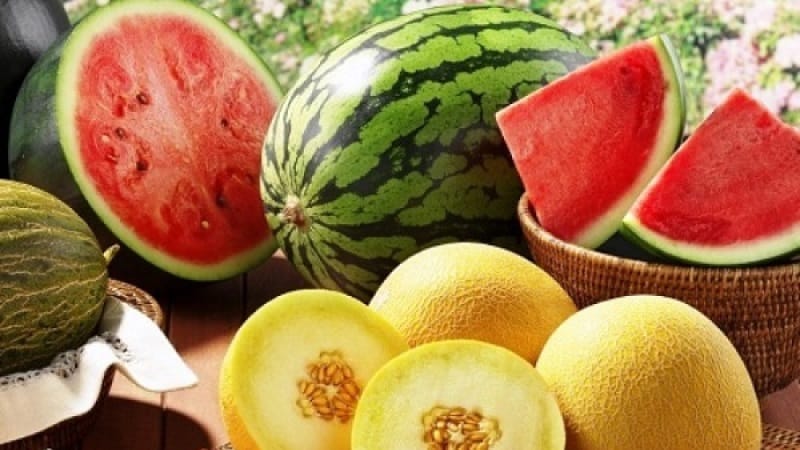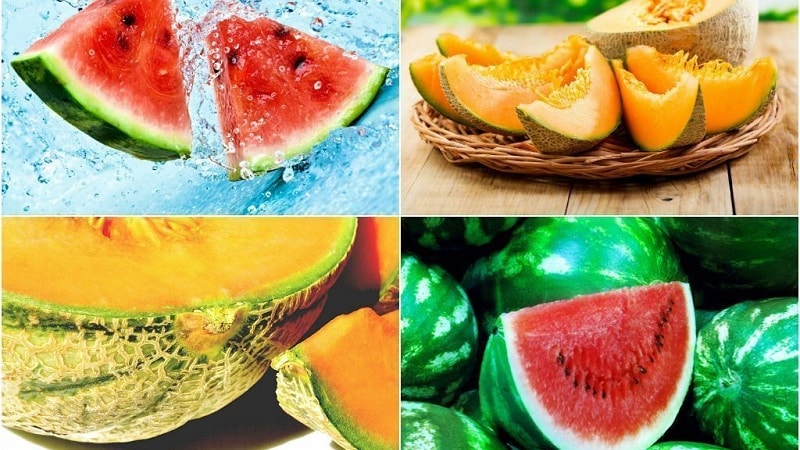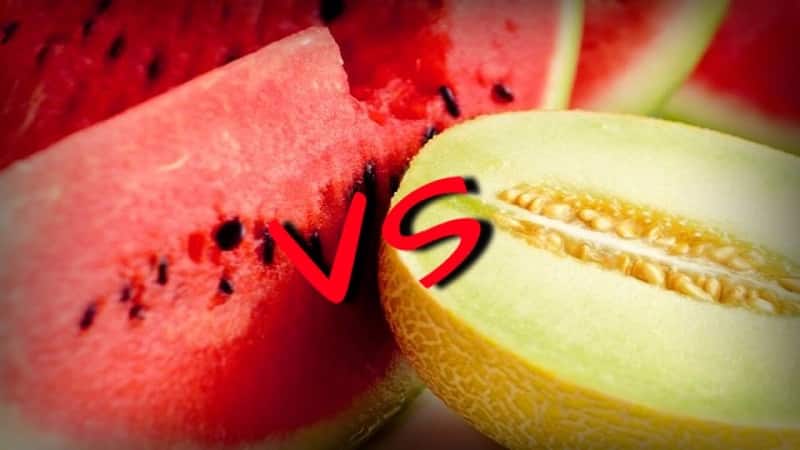What is healthier - watermelon or melon: comparison of compositions and properties
In this article we will talk about the most popular summer delicacies: watermelon and melon. Without a doubt, each of these fruits is delicious and has its fans. At first glance, it may seem that watermelon is more watery and has less pulp. However, this is not true: both melon and watermelon are 90% water. Which one is healthier, higher in calories, and which fruit contains more vitamins and minerals? Let's figure it out.
Watermelon: composition and properties
Watermelon, like melon, belongs to the pumpkin family. Both the pulp and the rinds, which are pre-cooked with sugar, are eaten; they cannot be eaten raw.
Watermelon contains many useful substances. So, in 100 g of pulp:
- vitamin C – 7 mg;
- vitamin PP – 0.3 mg;
- vitamin E – 0.1 mg;
- vitamin A – 17 mcg;
- thiamine (B1) – 0.04 mg;
- riboflavin (B2) – 0.06 mg;
- pyridoxine (B6) – 0.09 mg;
- folic acid (B9) – 8 mcg.
The minerals in watermelon include:
- potassium – 110 mg;
- calcium – 14 mg;
- magnesium – 12 mg;
- phosphorus – 7 mg;
- sodium – 16 mg;
- molybdenum – 1.8 mcg;
- copper – 42 mcg;
- silicon – 12 mg;
- cobalt – 2 mcg;
- iron – 1 mg.
The fruit also contains selenium, chromium, fluorine and iodine in very small quantities.
In addition to these nutrients, watermelon contains essential amino acids: valine, arginine, tryptophan, lysine, isoleucine and phenylalanine. And the kernels of watermelon seeds contain about 50% fatty oil, which is actively used in cosmetology.

Calorie content and BZHU
100 g of watermelon pulp contains only 27-35 kcal. Protein – 0.7 g, fat – 0.1 g, carbohydrates – 5.8 g.In percentage terms it will look like this: 10.5%/3.5%/86%.
Due to the low calorie content of watermelon, it is used for mono-diets and on fasting days, especially since its pulp gives a feeling of fullness for a long time.
Benefits and harms
Due to its rich composition, watermelon is considered a useful vitamin product. Its effect is as follows:
- Helps break down kidney stones.
- Normalizes blood pressure and strengthens the cardiovascular system as a whole.
- Reduces the risk of heat stroke.
- Lowers blood cholesterol levels, prevents the development of hypertension, heart attack, stroke and atherosclerosis.
- Relieves attacks of bronchial asthma.
- Fights age-related vision changes.
- Increases male libido and improves potency.
- Reduces pain and inflammation in gout.
- Reduces the risk of prostate, breast, lung and skin cancer.
- Maintains normal weight.
- Strengthens the immune system.
Excessive consumption may result in harmful properties such as nausea, diarrhea and increased gas formation. This is due to the large dose of lycopene and potassium.
Pregnant women should limit their consumption of watermelon to prevent frequent urination in the last stages.
There are contraindications for which you should completely exclude watermelon from your diet:
- serious impairment of kidney and liver function;
- problems with urine flow;
- kidney stones with a diameter of more than 4 mm;
- diarrhea and persistent colitis;
- type 2 diabetes.
Important! Watermelon tends to accumulate harmful substances - nitrates. This is another factor due to which even healthy people should not abuse it.

Melon: composition and properties
Melon contains many nutrients, just like watermelon. In terms of vitamin C content (20 mg), it surpasses all other melons. In addition to ascorbic acid, melon contains the following vitamins:
- A – 67 mcg;
- B1 – 0.04 mg;
- B2 – 0.04 mg;
- B4 – 7.6 mg;
- B5 – 0.23 mg;
- B6 – 0.6 mg;
- B9 – 6 mcg;
- PP – 0.5 mg;
- K – 2.9 µg;
- beta-carotene – 0.4 mg.
From micro- and macroelements, melon contains:
- potassium – 118 mg;
- calcium – 16 mg;
- magnesium – 13 mg;
- sodium – 32 mg;
- phosphorus – 12 mg;
- chlorine – 50 mg;
- silicon – 82 mg;
- iron – 1 mg;
- iodine – 2 mcg;
- cobalt – 2 mcg;
- copper – 47 mcg;
- chromium – 2 mcg;
- fluoride – 20 mcg.
100 g of melon pulp contains such an amount of silicon that it covers the body’s daily needs by 270%. Silicon plays an important role in the natural synthesis of collagen.

Calorie content and BZHU
The calorie content of melon is 30-35 kcal. Proteins in 100 g of pulp - 0.6 g, fats - 0.3 g, carbohydrates - 7.4 g. Percentage - 7%/8%/85%.
The fruit contains a lot of fiber, which has a positive effect on intestinal motility.
Benefits and harms
Melon contains a large number of substances important for the normal functioning of the body and has beneficial properties:
- Removes toxins.
- Has a diuretic effect.
- Improves the condition of skin, hair and nails. Prevents the appearance of wrinkles.
- Normalizes female hormonal levels.
- Removes free radicals from the body, which reduces the risk of developing cancer.
- Strengthens the immune system.
- Reduces the risk of developing cataracts and macular degeneration.
- Strengthens blood vessels.
- Has a calming effect.
- Improves the functioning of the cardiovascular system.
- Positively affects joint health, preventing the occurrence of arthritis and osteoporosis.
- Has an anti-inflammatory effect.
- Helps with irregular bowel movements.
- Normalizes the functioning of the urinary system.
- Removes worms (one glass of melon juice on an empty stomach).
Harm to melon is caused by its improper use. It can manifest itself as frequent urination, diarrhea or hypervitaminosis.
Which is healthier: watermelon or melon?
Both fruits contain equally large amounts of water. This can make them appear empty and watery. But, as we have already found out, this is completely false.
The nutritional value of watermelon and melon is approximately at the same level and may vary depending on the place and conditions of their growth. If you want to rejuvenate your joints and appearance, you should lean on melon. If you are concerned about high blood pressure and cholesterol in the blood, then watermelon will help you.
These fruits have a positive effect on the urinary system, vision and immunity. They provide the body with a similar set of vitamins and nutrients.

Rules of use
By following the rules for eating watermelon and melon, you can avoid unpleasant consequences:
- Eat them two hours before or two hours after meals.
- Do not drink them with water or alcohol.
- Do not eat watermelon and melon with milk and dairy products.
- The daily norm of watermelon is no more than 1 kg.
- The daily norm of melon is 500-800 g.
Contraindications for their use:
- individual intolerance, allergies;
- problems with the gastrointestinal tract;
- kidney diseases.
Since watermelon and melon contain a lot of sugar, people with diabetes need to consume them with great caution. The standard daily dose should be halved.
Important! Excessive eating nursing melon a woman can cause colic in a child, and in watermelon - a change in the quality of milk.
Conclusion
Both melon and watermelon are very tasty and healthy. They have a lot in common: both fruits are diuretic and have a positive effect on vision and heart function.However, there are also individual characteristics: melon rejuvenates, and watermelon increases potency and reduces blood pressure.
Each of them contains a large amount of vitamins and minerals, the composition of which is only slightly different.